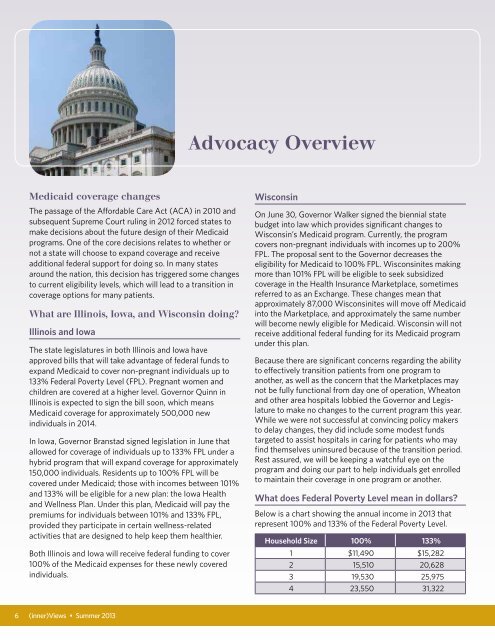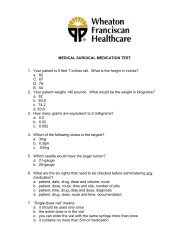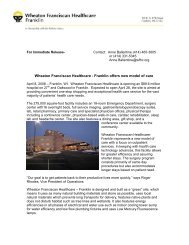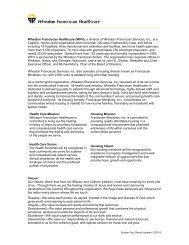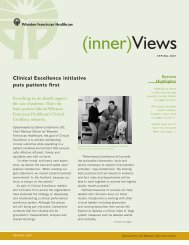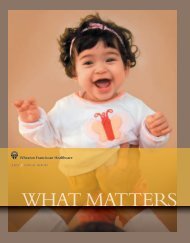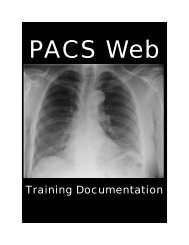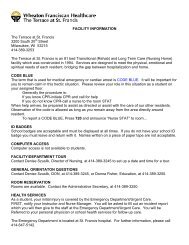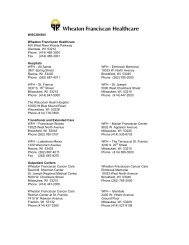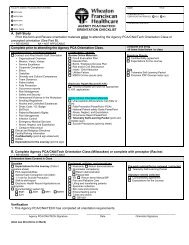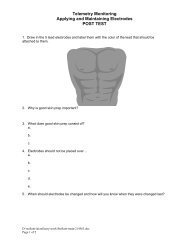innerViews_summer2013 - Wheaton Franciscan Healthcare
innerViews_summer2013 - Wheaton Franciscan Healthcare
innerViews_summer2013 - Wheaton Franciscan Healthcare
Create successful ePaper yourself
Turn your PDF publications into a flip-book with our unique Google optimized e-Paper software.
Advocacy Overview<br />
Medicaid coverage changes<br />
The passage of the Affordable Care Act (ACA) in 2010 and<br />
subsequent Supreme Court ruling in 2012 forced states to<br />
make decisions about the future design of their Medicaid<br />
programs. One of the core decisions relates to whether or<br />
not a state will choose to expand coverage and receive<br />
additional federal support for doing so. In many states<br />
around the nation, this decision has triggered some changes<br />
to current eligibility levels, which will lead to a transition in<br />
coverage options for many patients.<br />
What are Illinois, Iowa, and Wisconsin doing<br />
Illinois and Iowa<br />
The state legislatures in both Illinois and Iowa have<br />
approved bills that will take advantage of federal funds to<br />
expand Medicaid to cover non-pregnant individuals up to<br />
133% Federal Poverty Level (FPL). Pregnant women and<br />
children are covered at a higher level. Governor Quinn in<br />
Illinois is expected to sign the bill soon, which means<br />
Medicaid coverage for approximately 500,000 new<br />
individuals in 2014.<br />
In Iowa, Governor Branstad signed legislation in June that<br />
allowed for coverage of individuals up to 133% FPL under a<br />
hybrid program that will expand coverage for approximately<br />
150,000 individuals. Residents up to 100% FPL will be<br />
covered under Medicaid; those with incomes between 101%<br />
and 133% will be eligible for a new plan: the Iowa Health<br />
and Wellness Plan. Under this plan, Medicaid will pay the<br />
premiums for individuals between 101% and 133% FPL,<br />
provided they participate in certain wellness-related<br />
activities that are designed to help keep them healthier.<br />
Both Illinois and Iowa will receive federal funding to cover<br />
100% of the Medicaid expenses for these newly covered<br />
individuals.<br />
Wisconsin<br />
On June 30, Governor Walker signed the biennial state<br />
budget into law which provides significant changes to<br />
Wisconsin’s Medicaid program. Currently, the program<br />
covers non-pregnant individuals with incomes up to 200%<br />
FPL. The proposal sent to the Governor decreases the<br />
eligibility for Medicaid to 100% FPL. Wisconsinites making<br />
more than 101% FPL will be eligible to seek subsidized<br />
coverage in the Health Insurance Marketplace, sometimes<br />
referred to as an Exchange. These changes mean that<br />
approximately 87,000 Wisconsinites will move off Medicaid<br />
into the Marketplace, and approximately the same number<br />
will become newly eligible for Medicaid. Wisconsin will not<br />
receive additional federal funding for its Medicaid program<br />
under this plan.<br />
Because there are significant concerns regarding the ability<br />
to effectively transition patients from one program to<br />
another, as well as the concern that the Marketplaces may<br />
not be fully functional from day one of operation, <strong>Wheaton</strong><br />
and other area hospitals lobbied the Governor and Legislature<br />
to make no changes to the current program this year.<br />
While we were not successful at convincing policy makers<br />
to delay changes, they did include some modest funds<br />
targeted to assist hospitals in caring for patients who may<br />
find themselves uninsured because of the transition period.<br />
Rest assured, we will be keeping a watchful eye on the<br />
program and doing our part to help individuals get enrolled<br />
to maintain their coverage in one program or another.<br />
What does Federal Poverty Level mean in dollars<br />
Below is a chart showing the annual income in 2013 that<br />
represent 100% and 133% of the Federal Poverty Level.<br />
Household Size 100% 133%<br />
1 $11,490 $15,282<br />
2 15,510 20,628<br />
3 19,530 25,975<br />
4 23,550 31,322<br />
6 (inner)Views • Summer 2013


